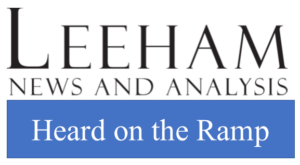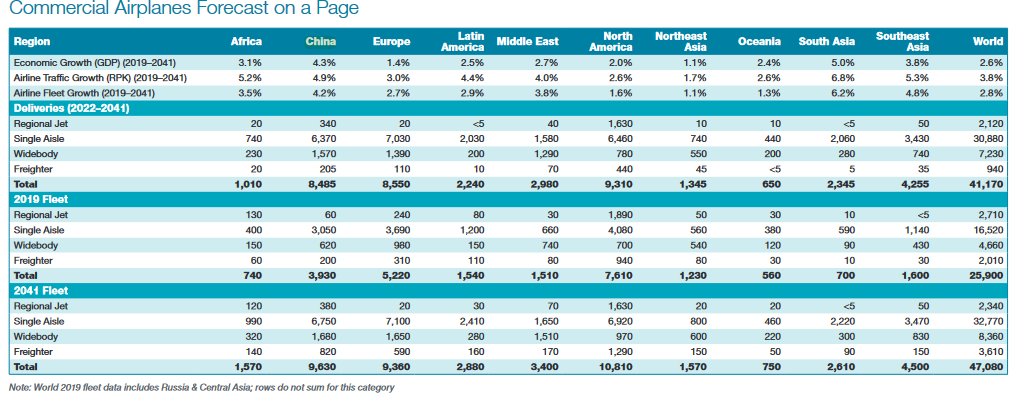Leeham News and Analysis
There's more to real news than a news release.
New software issue delays some 737 MAX deliveries/Update
By Scott Hamilton and Laura Mueller

Boeing 737 MAXes in long-term storage at Moses Lake (WA). About 140 MAXes ordered by China remain undelivered. Credit: Leeham News.
Update, March 9, 2023: Some readers have interpreted this story as reporting that new deliveries directly from Boeing are being delayed. The wording is somewhat ambiguous. To clarify, airplanes purchased by lessors–who have taken delivery from Boeing–are experiencing delays in delivery to their lessees due to the issues with the Boeing software reconfiguration described.
March 6, 2023, © Leeham News and Airfinance Journal: A new issue with a software program is delaying deliveries of some Boeing 737 MAXes by up to a year, joint reporting by Leeham News and Airfinance Journal learned. The Federal Aviation Administration views its use as a safety matter that must be resolved before delivery on aircraft undergoing reconfiguration. It is not a safety issue when aircraft are delivered to the originally intended operator.
The Boeing software, called Option Selection Software (OSS), is used by Boeing to identify software installed on 737 MAXes that must be reconfigured when the airplanes are going from one airline going to another. For example, if a 737 was built for Airline A and instead it will go to Airline B, reconfiguring the cockpit display and related systems may be necessary. We are told that MAXes and 787s are impacted, given their large inventories of airplanes that have been stored long enough that some original customers no longer wanted the aircraft. When sold or reconfigured for a different operator, Boeing uses the OSS to reconfigure the software and identify related parts for any changes.
This issue has not been reported previously.
HOTR: China’s desire for aerospace self-sufficiency threatens Airbus, Boeing
By the Leeham News Team
China’s goal for C919
 China’s state-run aviation industry is working toward self-sufficiency because of sanctions. But it is these same sanctions that will make it difficult to achieve.
China’s state-run aviation industry is working toward self-sufficiency because of sanctions. But it is these same sanctions that will make it difficult to achieve.
Beijing wants to shift to supplying its single-aisle jet needs to the COMAC C919 by the end of this decade, according to a person familiar with the situation. But ramping production up to meet future demand is difficult under the best of circumstances.
With Western-built suppliers a key to the development of the C919, including the CFM LEAP 1C engines, there is little chance the domestic industry can shift exclusively to domestic suppliers on the scale required in the time desired.
Regardless of the feasibilities, these goals are bad news for Boeing—and most likely for Airbus, too.
Boeing’s dilemma with China is well known. Aside from the geopolitical challenges between China and the US and the well-known slow return to service of the in-country 737 MAXes, Boeing can’t deliver 138 new-build MAXes to China.
Deliveries are blocked for the aforementioned geopolitical considerations. Beijing’s three-year-long zero-COVID policies cratered domestic demand. With the policies recently lifted, passenger traffic is building but it is still well below pre-pandemic levels.
But that’s not all.
Outlook 2023 for China’s COMAC and Russia’s UAC
Subscription required
By Bjorn Fehrm
Jan. 12, 2023, © Leeham News: China’s civil airliner OEM, COMAC, made significant progress during 2022. It achieved Chinese certification for its C919 158-seat domestic airliner in September last year, with the first delivery to the launch customer, China Eastern Airlines, in December. The first aircraft will be used in trial operations during 2023. The C919 follows the regional ARJ21, which has been in operation in China since 2016.
The progress, after several delays, of the COMAC programs is in stark contrast to the airliner progress of Russia’s UAC. The slow progress for the SSJ100, MC-21, and Il-114 programs has now ground to a standstill since the invasion of Ukraine and the ensuing Western sanctions.

Figure 1. Test flight of the first series delivery C919 of China Eastern Airlines. Source: Wikipedia.
Summary:
- China and COMAC have made significant progress in 2022 and will gradually build a viable airliner industry from 2023 onwards with a regional and single-aisle offering.
- The opposite is true of Russia’s UAC. A once viable airliner industry is now crushed by the Kremlin’s decision to invade Ukraine.
How much can China’s traffic growth slow? A look at Japan
Subscription Required
By Vincent Valery
Introduction
Dec. 12, 2022, © Leeham News: The Chinese commercial aviation market is now the second largest in the world after the United States. Growth has been very robust in recent decades, and all major OEMs forecast things to stay this way in the next two decades.
However, the Chinese economy’s GDP (Gross Domestic Product) growth rate slowed down significantly throughout the 2010 decade: from around 10% to 6% in 2019. Separately, China’s working-age population peaked during the same decade.
The growth in passenger traffic has historically had a strong correlation with GDP growth. Several studies have shown that passenger traffic has grown 1.5x to 2x faster than GDP. The consequences of a potential passenger traffic growth slowdown in China are, therefore, significant for commercial aircraft OEMs.
Another country in the Asia Pacific region faced a similar situation in the early 1990s: Japan. Even though there are substantial differences between the two countries, analyzing how things played out in Japan could help understand what lies ahead for Chinese passenger traffic growth.
Summary
- Demographic and economic parallels;
- Competition from high-speed rail;
- As Japan’s GDP grew, so did air and train travel;
- Explaining the 2010s Japan air traffic boom;
- Significant differences between China and Japan.
China will accelerate development of its commercial aerospace sector
Subscription Required
The second of two articles.
By Scott Hamilton
Nov. 21, 2022, © Leeham Co.: Western aerospace companies that invested in China face challenging times ahead in a changing trade environment.

The COMAC C919 is a means to an end in the development of China’s commercial aerospace industry. Credit: Leeham News.
This is especially true for US companies. The overhang of trade and political tensions between the US and China makes for difficult times ahead. European companies are less threatened. Nevertheless, these face uncertainties as China strives to build its own commercial aerospace industry.
This effort “puts western companies that have made capital investments in Chinese capacity in a difficult situation just structurally because they have either JVs or WFOES (Wholly Foreign-Owned Enterprises) or other engagements with Chinese-based industrial assets that will be hard to navigate simply from a trade compliance perspective,” says Michael McAdoo, Partner & Director, Global Trade and Investment for Boston Consulting Group.
“Non-Chinese companies now have a very difficult environment to navigate versus a decade ago. I think there will be a huge push to create the capacity, for engines, for airframes, and for key systems.”
McAdoo The C919 essentially was China going shopping basically for what it considered to be best of breed and all these different technologies. The majority of these come from Western suppliers. Then they were integrated into China with some Chinese design and build structures, but even that structure had some western partners at various places.
Related articles:
Excluding China in Boeing forecast recognizes trade, geopolitical realities
Subscription Required
By Scott Hamilton
Nov. 8, 2022, © Leeham News: Boeing CEO David Calhoun last week said Boeing’s future through at least 2025/2026 doesn’t include assuming China is part of its equations.
It’s a good thing. Relations between the US and China are heading south. The Pentagon last week outlined an extremely pessimistic outlook pointing to future military conflict with China. The Biden Administration not only didn’t reverse tariffs imposed in 2017 by the Trump Administration, but in some respects, Biden upped the game.
Related Article
Boeing started remarketing 737 MAXes ordered by China. It also began taking engines off those airplanes to put onto new production aircraft. Boeing—and others—don’t see China taking any new deliveries from China in the next two or three years or placing orders with Boeing.
Trade publication Airfinance Journal reported Oct. 31 that nearly one in five leased aircraft owned by Chinese lessors are being offered for sale to non-Chinese interests. LNA previously reported that Chinese lessors were being allowed to accept a small number of MAXes providing they were leased outside China.
A trade expert for Boston Consulting Group outlined how he sees relations between China, the US and Europe in an Oct. 26 interview with LNA.
Summary
- China considers the US to be the enemy, one well-placed observer notes.
- The US, EU see China differently.
- Airbus has a window of opportunity.
China still needs Boeing as much as Boeing needs China, despite interminable limbo
Subscription Required
By Scott Hamilton
Oct. 31, 2022, © Leeham News: China needs Boeing as much as Boeing needs China was the conclusion of an analysis by LNA in July 2021. A trade expert last week agreed. Airbus and China’s COMAC won’t be able to fill the future demand forecast for China.
Michael McAdoo, Partner & Director, Global Trade and Investment of the Boston Consulting Group (BCG) in Montreal and a former strategic chief of Bombardier Commercial Aircraft, told LNA in an interview last week that China needs the Boeing 737 MAX and widebody airplanes to meet demand in the near-to-medium term.
It will be long-term before China’s commercial aviation industry will be competitive with airplane designs and production.
Summary
Forecasts for China’s demand for jet aircraft are consistent between Airbus and Boeing. But COMAC, which is the leader of China’s burgeoning commercial aviation industry, is significantly higher in its forecast. The independent Japan Aircraft Development Corp (JADC) is significantly lower.
- Boeing forecasts that China needs 8,485 new jets through 2041.
- Airbus forecasts 8,420 new aircraft will be needed through 2041.
- COMAC forecasts China will need 9,084 aircraft through 2040.
- JADC is more conservative, forecasting a requirement for 6,172 new jets in China through 2041.
China will account for 21% of the world’s new aircraft deliveries through 2041, Boeing says.
UPDATE: Calhoun upbeat on cash flow despite fifth consecutive quarterly loss
By Bryan Corliss
Oct. 26, 2022, (c) Leeham News: The Boeing Co. posted a loss from operations of nearly $2.8 billion for the third quarter, citing losses on fixed-price defense development programs that offset an overall 4% growth in revenues.
 The consensus of Wall Street analysts earlier this week was that Boeing would announce profits of 13 cents a share and would break a streak of four consecutive losing quarters. Instead, Boeing posted a loss of $5.49 a share.
The consensus of Wall Street analysts earlier this week was that Boeing would announce profits of 13 cents a share and would break a streak of four consecutive losing quarters. Instead, Boeing posted a loss of $5.49 a share.
However, in a conference call with stock analysts later in the morning, Calhoun was upbeat, emphasizing Boeing’s positive operating cash flow of nearly $3.2 billion for the quarter.
“This quarter was a big one for us,” he said. “We hit a marker … to generate positive cash flow.”
Boeing booked losses of roughly $1.95 billion on two defense programs, CFO Brian West said: KC-46 tankers and new Air Force One presidential transports. Both are fixed-price contracts for commercial jet conversions that forced Boeing to eat any cost overruns.
“We aren’t embarrassed by them,” Calhoun said. “They are what they are.”
But in an interview with CNBC’s Phillip LeBeau Wednesday, Calhoun said Boeing will not do fixed-price defense contracts in the future. “That is not our intent.”
Summary:
- BCA: 737 and 787 deliveries resume; engines in short supply
BDS: ‘Labor instability’ hurts key programs
Calhoun: Boeing ‘supports China’ but is re-marketing planes
Read more
Pontifications: Some customers face 3 month delays in current 737 MAX delivery stream
Sept. 5, 2022, © Leeham News: Boeing has been delivering 737s from its stored inventory and its new production line more slowly than desired. Some customers face a three-month delay, even as Boeing tries to return to normalcy following the 21-month grounding of the MAX and the impact of the two-year pandemic.
The supply chain is a key culprit. Reconfiguring stored airplanes for lessees or buys after a change from the original operator is another. Engine shortages are still another.
BOC Aviation, a lessor headquartered in Singapore, faces three months delays, Robert Martin, the CEO, said in an interview with LNA.
Can China pass on Boeing airplanes? A deeper look
Subscription Required
By Vincent Valery
Introduction
Aug. 8, 2022, © Leeham News: The FAA lifted the Boeing 737 MAX grounding more than 18 months ago. However, Chinese airlines still have not returned their 737 MAX fleets to passenger service.
Chinese airlines have also not taken delivery of any 737 MAX since March 2019. Separately, a Boeing 777-300ER for China Southern Airlines has now been pending delivery for more than two years. While Airbus announced a large A320neo order from Chinese airlines on July 1, no similar order materialized for the 737 MAX at the Farnborough Air Show.
The above raises the question of whether China intends to place new commercial aircraft orders with Boeing. Last year, LNA concluded that China could not rely exclusively on Airbus and COMAC to meet its aircraft requirements.
This article revisits whether Chinese airlines can do without Boeing for single-aisle and twin-aisle aircraft. Airbus announced its intention to increase A320 family production to 75 per month by 2025. The analysis incorporates replacement needs but also looks at different growth assumptions to see whether output by non-Boeing OEMs can accommodate the fleet requirements of the Chinese market.
Summary
- Current China passenger fleet profile;
- Fleet replacement and growth rate assumptions;
- Estimating maximum possible production rates for China without Boeing;
- China needs Boeing airplanes in most scenarios.






